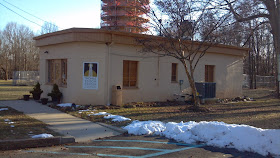That was my rationale for a recent visit to Bayonne. From a geographic perspective, it looks great: located at the southern tip of the peninsula separating Newark Bay from the lower Hudson River, the city's borders are mostly shoreline. However, this advantage, combined with proximity to New York and Newark, made it the perfect place for industry. Starting with the construction of the city's first oil refinery in 1875, Bayonne became heavily industrialized, resulting in a gritty image and negative environmental implications. So much for the birds, right?
Not so fast. From the Meadowlands to Linden, we've seen some incredible wildlife in areas that are bouncing back from years of neglect or abuse. As for Bayonne, local birders have reported interesting species in and around the waterfront parks, so I decided to take a look. A quick check of the map showed a nice bit of marshy open space right on the bay, accessible directly from Route 440. Granted, you can't expect much from visiting a marsh in the midst of an extended period of sub-freezing weather -- it's highly unlikely you'll find anything but ice -- but I figured the bay might reveal some interesting ducks. And who knows? I might run into a few historical markers along the way.
After navigating the heavy truck traffic of US 1 and 9 and then 440, I made the quick turn into a small parking lot for Rutkowski Park. As promised, it's on the waterfront, easily accessible by car if you have good reflexes and no 18-wheelers are barreling down your neck. The only other vehicle in the parking lot was a utility van.
The park itself seems rather unassuming from the highway approach -- a somewhat hilly field with paved paths -- one headed toward the water's edge and another headed straight back to the marsh. Walking along the bay, I soon found the men responsible for the van, braving the chill with rod and reel despite signs warning the dangers of eating locally-caught crabs. A little farther along, I saw a few mallards and buffleheads drifting not far from shore.
 |
The ELCO crane, with the NJ
Turnpike extension in the background.
|
This contraption was a crane which once stood within the boatyard of the Electric Launch Company, better known as Elco. Now replaced by the Boatworks condo development, Elco operated at its Avenue A and 8th Street location from 1892 to 1949.
The company's roots were in pleasure and utility craft, building electric-powered boats (equipped with Edison storage batteries, if my research proves correct) for clients including Charles Lindbergh and Henry Ford. However, its real claim to fame was as a defense contractor, constructing fast boats for the United States and its allies during both World Wars. Specifically, Elco built the 80-foot Patrol Torpedo (PT) boat, the primary motor torpedo boats used by the Navy during World War II. The men and women of Elco built 170 PTs at Bayonne, and the crane at Rutkowski Park once lowered the newly completed vessels into Newark Bay.
Known as mosquito boats for their ability to reach a target almost silently, the wooden-hulled, gas powered PT boats carried crews of 12 to 14 men and performed multiple duties, from laying mines to rescuing stranded aviators. Some even participated in the D-Day invasion at Normandy. The most famous of the Bayonne alumni was PT-109, which, under the command of Lt. (j.g.) and future present John Kennedy, was rammed and sunk by a Japanese destroyer in August 1943.
Unfortunately, Bayonne's Elco crane is likely one of the few large and authentic relics of the PT. Only one of the boats still exists, according to the U.S. Navy's Naval History and Heritage Command, the rest having been disposed of shortly after V-J Day. Elco itself merged with Electric Boat of Groton, Connecticut in 1949 to form General Dynamics; entrepreneurs revived the Elco name in 1983 to manufacture electric boat motors and pleasure craft in Athens, New York.
As for the rest of Rutkowski Park, I've vowed to return once the weather warms and the marsh thaws a bit. Having found some unexpected history, I can't wait to see what might be lurking in the tall grass along the boardwalk.
Many thanks to Jodi Jameson of Hackensack Riverkeeper for the heads up on Rutkowski Park!









